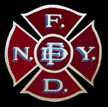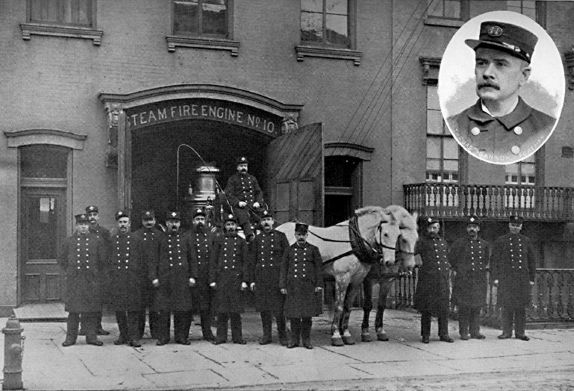 |
 |
ENGINE 210 BROOKLYN ORGANIZED AS ENGINE 10, BROOKLYN FIRE DEPT ORG. 160 Carlton Ave. FQ Vol. (Sep. 15, 1869) CHANGE To Engine 10, FDNY (Jan. 28, 1898) CHANGE To Engine 110 (Oct. 1, 1899) RELOC. 189 Vanderbilt Ave. (Apr. 15, 1912) CHANGE To Engine 210 (Jan. 1, 1913) NQTRS. 160 Carlton Ave. (Oct. 7, 1913)
 |
Engine Company 10 of the Brooklyn Fire Department
The annals of Engine No. 10 show that beside excellent discipline and hard work a single fire-company may do a great deal for the good of the entire Department through the careful training of the individual firemen. Engine Company No. 10 had done that long before it came under the present pay system. As No. 9 in the Volunteer Department, it was a " training-school " for firemen, and turned out good men, as their subsequent records show. The " school" has not changed its location for many years, as the Volunteer No. 9 occupied for a long time the house on Carlton Avenue, near Myrtle, that is now the house of No. 10, and save for its slightly antique arrangements is as serviceable as ever.It is doubtful if there is a more important fire district in Brooklyn than District 4, which calls Engine No. 10 in the first-alarms. Part of the district is occupied by costly residences, and there are also many churches and public buildings in it. Many of the largest buildings are anything but fireproof, and if once well started burning would make great fires. In many of the big flat-houses in whose the district live hundreds of persons whose lives are constantly dependent upon the prompt action of the firemen, and in such case never has Engine No. 10 been found lacking in either promptitude or energy. Since Engine No. 10 was reorganized under the pay system, she has had six Foremen, William Harris, Charles McDonough, W. A Beardall, Peter Farrell, James 1;. Murray and James Gannon, the present Forman McDonougll and Beardall have retired, but al] the rest are in active service and are excellent firemen. At nearly all the big fires that have occurred in Brooklyn since 1873, No. 10 has done noticeably good work. At the burning in 1873, of the big storehouses owned by Woodruff & Robinson at the foot of Conover Street, No. 10 was on hand promptly and for sixty hours, with but one relief of six hours, the engine, an Amoskeag that was then only a year old, pumped steadily at the big blaze. Almost every minute of the working, time__54 hours___the men were were in danger of their lives from the possibility of the fall of the lofty walls. Toward the last of the blaze Fireman Bennett, who occupied a position near one wall that was evidently cracking, was called back by the Forman Forman and his fellow-firemen. He rushed backward just as the wall began to topple toward him, but he was a little too late and the crumbling bricks knocked him down. When he was taken out it was thought that his injuries would prove fatal, but after some time in the hospital he recovered. During the last hours of the work at this fire, the men of No. 10 were so blackened by smoke and worn out by the long hours of continuous work, that it was not for several days that they recovered either their complexions or their natural strength and activity. The burning of the Havemeyer & Elder sugar refinery, at the foot of North Second Street, Jan. 13, 1881, was another event that brought out the good qualities of Engine No. 10. The alarm was sent in shortly after four o'clock in the afternoon, and although thc fireboat boat " Seth Low " pumped millions of gallons of water onto the big building, the land forces were kept at work until the next morning at seven o'clock. During all the night No. 10 held a dangerous position near the enormous building, which was one mass of flames within the lofty walls that bulged threateningly but did not drive the men belonging to Engine No. 10 from their work, although several of them had narrow escapes from falling timbers and masonry.
All of the good work done by No. 10 has not been confined to the saving of property When fire started in the bakery Oil St. Mark's Avenue, near A1bany, and adjoining St. John's Home, the men of No. 10 worked faster and with more energy than cvcn usual with them. In the Home which is under the Roman Catholic Orphan Asylum, there were more than five hundred destitute boys, none older than fourteen years and many not three years old. The flames from the bakery extended to the Home, and three alarms were sent out at once. The thirty-six Sisters of Charity that had the care of the little ones aided the firemen in preserving the little children from panic or death in the flames. The men of No. 10 were among the first to enter the Home, where the children stood in frightened groups. Fortunately the fire was in the rear and the little orphans were able to march out of the front doors between the lines of big firemen. Many of the smallest of the children were carried out by men from No. 10 After the children were taken out the fire was subdued in good season.
When an engine working at a fire comes so near being burnt up herself that water has to be pumped on her instead of the burning building, the fact should be an excellent proof of tile class of work that engine-company does. Such an incident occurred to Engine No. 10 at the burning of Palmer's cooperage on Kent Avenue on the first day of June, 1891 Engineer William F. Kingsland had just settled down to the working of the engine when flames shot out from the building and hemmed the engine in between it and tile river, drove the men awayÑthough Engineer Kingsland stuck as long as he could and reaching the engine, burned off the tongue and set the wheels ablaze. Nothing saved her from destruction but a deluge of water from neighboring engines, which was kept Up till the fire was over, alla the horses could be brought down to drag away the charred and blackened machine At this fire Engine No. 15 was entirely destroyed in much the same manlier that No. 10 was damaged. Had it not been for the thorough discipline and the presence of mind of the men of No. 10 there would have been several of them burned to death at the Smith, Gray & Co. fire that occurred in Feb., 1892 in the big building at the corner of Flatbush and Fulton Avenues. The fire was in the basement when No. 10's crew entered the building with their pipe. After a few hours' work it was evident that the fire was deeply rooted, but the men were so busy working that they did not notice the clouds of smoke that were pouring up from the floor behind them until they were almost overpowered. Foreman Gannon ordered the crew to quit work and run for their lives. There was no time to haul out the hose and it looked for a few minutes as though the half-suffocated men were not going to find their way through the black wall of smoke that was between them and the outer doors. Foreman Gannon decided to make a rush, trusting to his knowledge of the building to point him in the right direction. His men dropped the hose and followed. After what seemed hours to the men, who were holding their breath lest they should inhale the deadly smoke, shouts from outside guided them to the safe exit, and with parched throats and blackened faces they stumbled out into fresh air. In the history of Engine No. 10 there are many instances of such thrilling work and narrow escapes, but the training of the men and the discipline of the company has stood in good stead and serious accidents to the men are rare.
Foreman JAMES GANNON is among the oldest of the firemen now in the service of the Department. He is under middle height, but his frame shows that his strength is; greater than ordinary. He-was born in. Brooklyn on Dec. 24, 1845 and was in the old Volunteer Fire Department for five years and six months before the establishment of the new Department. Mr. Gannon was a member of Engine No. 12, of the old Department, and was appointed from that engine to No. 10. On March 1, 1887 he was promoted to the position of Assistant Foreman and in June, 1891 was made Fore man. His work as a fireman has proved his fitness for the position, and although a very quiet and reserved man, he is popular with all the men under him.
Assistant Foreman William H. BROWN, JR. was born in New York City, Sept. 18, 1862, and appointed to Engine No. 10 in 1887. He is a cool, careful fireman with a good future before him and a good record in the past. present rank Feb. 13, 1892.
Engineer William F. KINGSLAND was born in Brooklyn, Jan. I I, 1847,, and was appointed Dec. 21, 1872. He has shown in many instances that he knows what his duties are and how to perform them. On Feb. 15, 1891 he was promoted to the rank engineer .
ALENTINE HENDRICKS was born in Brooklyn in 1847, and appointed to En No. 10, April 1, 1881.
ANDREW W. BERTH was born in Brooklyn, Oct. 22, 1857. He was appointed April 7, 1885.
JOHN J. MULLALY was born in Ireland, March 25, 1849, and came to America.
JOHN FEENEY was born in Ireland, in 1842. He came to this country and served when a young man, entering the Department in April, 1878, after a term in the U. S. Navy, later entering the Department, May 3, 1870.
HENRY F. MAGUIRE was born in Brooklyn, Feb. 22, 1866, and was appointed to Engine No. 10, Feb. 11, 1891.
JOHN J. MULDARY was born in Brooklyn, Jan. II, 1862, and was appointed April' 26, 1886.
FRANCIS I'. CREIGHTON was born in Brooklyn, Sept. 15, 1857, joining the Fire Department, March 3, 1883.
EDWARD SHAUGHNESSEY was born in Greenwich, Conn., on St. Patrick s Day, 1844. He was made a fireman on Dec. 11, 1873.